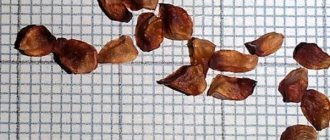How to choose a variety of crocuses for forcing?
Most often, large-flowered varieties of spring crocus (Crocus vernus), also called Dutch hybrids, are used for forcing: the white variety “Joan of Arc”, variegated “Pickwick”, “Striped Beauty”, “King of the Sprayed”, varieties of various shades of purple- blue colors “Remembrans”, “Grand Maitre”, “Flower Record”, “Vanguard”, “Grand Lila”, “Purpureus Grandiflorus”, with expressive flowers 4-5 cm in diameter.
Large flowers, up to 5-7 cm in diameter, are found on the yellow crocus (Crocus flavus), represented by the Ladgest Yellow variety. Each selected corm produces up to 5 flowers.
The flowers of the Tomasini crocus (Crocus tommasinianus) are slightly smaller - 3-4 cm in diameter. A common variety is "Ruby Giant", which is reddish-purple in color. The height of the plants is the same as that of the spring crocus, 15-20 cm, up to 3 flowers are formed from one bulb.
Other spring-blooming crocuses also lend themselves well to forcing. Of these, hybrid varieties obtained from the golden crocus (Crocus chrysanthus), combined into the Chrysanthus group, are often found on sale: bluish-white “Blue Pearl” and “Prince Claus”, yellow “Dorothy”, “Mamut” “Goldilox” “Romance” and “Saturnus”, cream “Cream Beauty”, two-color “Advance”, varieties with contrasting colors of the outer petals “Gypsy Girl” and “Blue Bird”.
They are more miniature, 10-15 cm tall, but, as a rule, produce 3-4 flowers from each corm 6/cm in circumference. And the variety of crocus ankira (Crocus ansirensis) “Golden Bunch” lives up to its name and really blooms in “golden clusters” of 5 flowers! However, in flower size (2-3 cm in diameter), they are all inferior to Dutch hybrids.
The earlier the planned forcing, the larger the corms you need to choose. They are often sold with sprouts already protruding - this does not affect the quality of forcing. Before planting, purchased planting material is stored in a dark, ventilated place at a temperature of 170C, having previously been freed from packaging. The air humidity should be such that small corms are not dried out, but not too high, at which there is a risk of developing penicillosis - green mold.
For forcing by the New Year or in January:
- 1 week after digging in June at a temperature of 340C;
- 2 weeks at 200C;
- Until August 10 – at 170C;
- Then before planting - at 90C.
Planting date is at the end of September.
For forcing in February-March:
- Until the beginning of August - at 200C;
- Then before planting – at 170C.
Planting period is from October 1 to November 15.
Nature arranges it in such a way that each bulbous plant must go through certain stages of development before flowering - a period of rest when the temperature drops, rooting, warming up and awakening, active growth. It is impossible for a person to cancel this order, but flower growers have figured out how to outwit the bulb.
To do this, environmental conditions (humidity, light, temperature) are artificially created that simulate the alternating change of seasons. Only the “seasons” replace each other at an accelerated pace.
As a result, blooming crocuses delight with cheerful bouquets both in the winter cold and at the first signs of spring. Usually, when forcing crocuses, they want to get a friendly, abundant flowering by a certain date. To do this, you need to follow the rules of storage, planting and care.
Fields of crocuses in the mountains
Forcing crocuses also involves proper preparation of the bulbs, because without it it is very difficult and almost impossible to control flowering. First of all, after purchasing planting material, it is left to lie at room temperature for a week. Then they begin “hardening procedures” and gradually lower the temperature, transferring the corms to a cooler room.
In the end, everything should end with the crocuses ending up in the cellar or refrigerator, where the air temperature fluctuates between 3-9 degrees Celsius (no higher and no lower). They must stay there for at least 20 days, or even a whole month.
The timing of planting bulbs directly depends on the specific date. In general, you need to focus on the fact that 70-90 days pass from planting to flowering.
For planting, it is better to take wide bowls - crocuses take root better in them. Be sure to add drainage to the bottom of the bowl and fill it with nutritious soil.
When forcing crocuses at home, the bulbs are planted in such a way that they do not come into contact with the flowerpot or with each other, and are completely covered with earth or other material, leaving a small tail. This way the stem will grow straight. Then the bowl is placed in a cool, dark place until the crocuses sprout.
Spring-blooming crocuses are chosen for forcing. The earlier you need to get flowering, for example in December, the earlier the variety should be preferred. Late varieties are suitable for flowering at the end of April or May.
It is recommended to prefer one variety of flowers for forcing in one container. Plants of different varieties may not bloom at the same time, or tall and large flowers will obscure smaller ones. In both cases, the decorativeness of the bouquet will suffer.
https://www.youtube.com/watch?v=nnia0XMbzJE
Blooming crocuses in early spring
A mixture of varieties is good for a spacious flower basket, where bowls with bulbs are placed. A composition of alternately blooming multi-colored crocuses retains a spectacular, elegant appearance for a long time.
Experienced distillers advise making the mixture yourself, this guarantees a set of truly different varieties. In purchased ready-made kits, there is often a predominance of one hybrid.
Varieties with large flowers are more decorative. The hybrids of Dutch selection are considered the best. Small flowers are delicate and touching, but not so spectacular. The choice depends on the preferences of the grower. When making a decision, you need to remember that the image of flowers on the packaging is usually enlarged; in reality they may look different.
Another nuance that should be taken into account is the size of the bulbs. For forcing, one-dimensional and largest available ones are selected. They produce flowers earlier, more abundantly and in larger sizes. If they are different sizes, then they will bloom at different times.
In order to drive out a crocus by a certain date, you need to know when to plant the bulb in a pot and how to care for it afterwards. If you want to receive a bouquet for the New Year, you need to plant the bulbs in a pot in the second half of September. If you plan to bloom crocuses at home by March 8, then planting should be done in mid-November.
On average, 3.5-4 months pass from the moment of planting to the start of flowering of crocuses.
Here is an approximate diagram by which you can calculate the time for planting dug crocus bulbs for forcing. Pay attention to the storage time and temperature of the bulbs from the moment they are removed from the ground until planting for forcing.
Forcing bulbs at home is carried out in several stages:
- digging and selecting suitable bulbs;
- temperature treatment;
- planting bulbs in boxes;
- providing plants with the required conditions for premature flowering.
If the forcing was carried out correctly, the stunningly beautiful flower will be ready just in time for the New Year or International Women's Day. We will tell you below what kind of care flowers require for forcing.
The general principles of forcing by a certain date are the same for all bulbous plants. But there are features of growing flowers of various genera and varieties. For example, the technology for forcing tulips by March 8 is slightly different from forcing daffodils or hyacinths. Let's look at each in more detail.
To force hyacinths at home by March 8, as well as to force crocuses, you need absolutely healthy bulbs about 5 cm in size. The sooner you plan to get a flowering plant, the larger the planting material you need to choose. Unlike other beautifully flowering bulbs, the temperature of the preliminary summer storage of the bulbs is quite high: 25.5°C.
Then, until planting, the bulbs are stored in a dark room at a temperature of 17°C.
Bulbs are planted:
- towards the end of September, subject to planned flowering by the New Year;
- from the beginning of October to November 15, if flowers are needed by March 8.
Plants are planted in pots filled with a mixture of sand or soil and peat in 1:1 proportions. The bulbs of hyacinths and crocuses are not buried - at least a third of the bulb should be above the ground.
Water the planted bulbs very carefully - hyacinths and crocuses, especially those brought from Holland, easily rot if there is excess moisture.
The temperature for keeping planted hyacinth and crocus bulbs for forcing for three to four months is 5-9°C. After sufficient development of flower stalks, crocuses or hyacinths are moved to a bright, warm room for forcing by March 8th.
IN THE PHOTO: To provide the bulbous plants with the necessary low temperatures, you can use a free refrigerator.
The adaptation of plants to light should be gradual. In the first two or three days in a new place, they are covered with dark paper or cloth for a couple of hours. The flowering of hyacinths and crocuses is also affected by the ambient temperature. For example, plants can bloom from seven to ten days, provided a constant room temperature of no more than 15–20 ° C.
How to get rid of daffodils for the holidays
Like growing tulips, forcing daffodils at home by March 8 or any other specific date begins with the correct choice of bulbs. The planting material must be undamaged, large, weighing at least 27 g. The above-described phases of preparing the bulb for planting for forcing are also required.
If you plan to force daffodils by March 8, at what time should you plant the bulbs? As a rule, it is better to do this in mid-November. For very early forcing, planting time is early October, for late forcing, the period is from mid-November to early December.
Good news for daffodil lovers - by March 3-6 it is possible to grow almost all varieties of daffodils! But if you want to get a blooming daffodil for the New Year or February 1 (for example, in honor of someone’s birthday), you should pay attention to the varieties:
- 'Barrett Browning';
- 'Carlton';
- 'Golden Harvest';
- 'Dutch Master';
- 'Mercato';
- 'Fortune';
- 'Ice Follies';
- 'Mawin Hood'.
Shelves with soil mixture, pots, boxes or containers are suitable for planting daffodil bulbs. The optimal composition of the mixture is the ratio of leafy and loose sandy loam soil is 1:2, and the required layer thickness is 2–3 cm. Drainage from clean river sand and clay shards is required. The tops of the bulbs should protrude 1–2 cm from the ground.
What is forcing crocuses?
1. Raise the temperature in the storage area with the bulbs to 20-30°C - this is necessary to accelerate the formation of the flower embryo. After 3 weeks from the start of temperature treatment, the “readiness” of the onion is checked by cutting it in half. If the flower embryo with stamens and pistils is clearly visible inside, then you can move on to the second stage.
2. The next step in growing tulips at home by March 8 is stimulating the growth of flowering shoots. For this purpose, positive low temperatures are required. The cooling period takes 16–22 weeks (minimum 16 weeks for early varieties, and up to 22 for late varieties). The temperature is lowered gradually - from 20-17°C in July-August to 12-9°C in September-October.
IN THE PHOTO: 9 - stamens, 10 - stigma (pistle), 4 - developing peduncle. If these elements are clearly visible, then it’s time to cool the bulb before planting.
How to ensure that tulips for forcing by March 8 at home bloom faster? First of all, use early varieties of tulips - they will be discussed below. And secondly, carry out temperature treatment in advance. Let us repeat once again: you cannot take any bulb of a beautifully flowering plant (be it a tulip, hyacinth or crocus), put it in water in November, and get a flower by New Year. This only works with bulbs specially prepared according to the scheme above.
So, you have in your hands bulbs that have gone through two long stages of heat treatment. Next, we decide on more precise planting dates and actually plant them.
Before you grow tulips by March 8 or another desired date at home, you need to take care of the correct substrate for the bulbs. There are three main requirements for it:
- naturalness;
- breathability;
- moisture capacity.
The height of the soil layer must be at least 6 cm!
It is best to use plastic or wooden boxes measuring 30x50x15cm as containers for storing bulbs. Two-thirds of the container is filled with substrate, then the tulips are planted for forcing in boxes.
IN THE PHOTO: Rectangular wooden containers are suitable for forcing tulips.
After planting the bulbs at a distance of 1–1.5 cm from each other, they are lightly pressed into the substrate and covered with it to the very tops. Next, you need to water the bulbs well and leave to take root. Care should be taken to ensure that there are no light sources in the room where the plants are located for the entire period of their cooling and rooting. An air humidity of 80–90% and regular abundant watering are needed.
In the first 5 days, boxes with bulbs are stored at the same temperature, then it drops to 2-3°C.
After the bud emerges from the bulb and is palpable, it is necessary to provide full illumination and increase the temperature to 18-20°C as soon as the sprouts reach a length of 6-8 cm.
IN THE PHOTO: You can expose the bulbs to light during forcing when the sprouts reach 6–8 cm.
After the buds begin to color, the temperature will need to be lowered again to 12°C - this is necessary to extend the flowering period. Flowers with buds that have already colored their color should be cut when they barely begin to bloom. It is recommended to do this before morning watering.
When should I plant tulips to bloom for the New Year? On October 1, the earliest varieties of tulips should already be planted in the ground and await the deadline for bringing them into a warm room on December 8-10.
Growing tulips at home for the New Year is possible using bulbs of the following varieties:
- 'Hibernia';
- 'Miles Bridge';
- 'Apricot Beauty';
- 'Christmas Map'.
If you need a bouquet of beautiful tulips for Valentine's Day, we recommend that you move them indoors to grow on January 25th.
Suitable varieties for a gift for Valentine's Day are 'Kis Nelis', 'Gander', 'Battle', 'Lustige'. 'Darwin hybrids' are excellent for the same purpose; they need to be stored for about three weeks at a temperature of 20°C, and one to two weeks at 17°C, after which the temperature drops to 9°C.
IN THE PHOTO: The best gift for your beloved on Valentine's Day is self-grown 'Kis Nelis' tulips.
When should I plant tulips so that they bloom by March 8? Early varieties are planted on October 1–5, later ones at the end of October. They are kept in the same cold as they were before planting until December 10-15. Then the temperature is lowered even further - to 2-3°C and in early February they are brought into a warm room.
Suitable varieties of tulips for forcing by March 8 are 'Beauty of Apeldoorn', 'Apeldoorn's elite' and other 'Darwin hybrids'. They are kept at a temperature of 20°C until a pistil is formed in the flower primordium.
To time a bouquet of tulips for April 1, keeping the bulbs warm until September 1 (23°C), further storing them at a temperature of 17°C and planting them in mid-October.
"April Fools" tulips:
- 'Albury';
- 'Kis Nelis';
- 'Pearles Pink';
- 'Diplomat';
- 'Robinea';
- 'Parade'.
The date for planting crocuses in the substrate (river sand) is the last ten days of October.
The first shoots appeared. Shooting date: December 03.
The sprouts are increasing, the bulbs are well rooted. Shooting date: January 04.
Planting of bulbs by size – February 20.
The planting of crocuses begins on February 26.
After three days the crocuses looked like this. Shooting date: March 01.
Two more days later. Shooting date: March 03.
The larger crocuses began flowering on March 6th. Shooting date: March 06.
This is what the crocuses looked like on March 8th.
And so the next day.
After forcing, the crocuses can be planted in a flower bed. To do this, wait until flowering ends. When the crocuses have dried leaves and peduncles, they are transferred to open ground. Next spring, flowering may not occur because the bulbs are severely depleted. And in a year, crocuses will delight you with full blooms already in the garden.
Forcing crops by March 8
By spring, crocuses are driven out in the same way as in winter. The only difference is the determination of planting dates. They shift by several weeks.
How to select planting material
To force crocuses, it is best to use healthy, large bulbs without signs of damage. Baby bulbs are not suitable for this purpose; nothing will grow from them, because the bulb is still too small. It is better to leave it for planting in open ground. In the first year, even outside it is unlikely to bloom.
Planting crocuses for forcing
By March 8, the forcing period falls on October-November. For planting, use the same substrate as in the case of winter forcing. In principle, the process is not much different.
During planting, some people prefer not to deepen the bulb and leave it on the surface until about halfway. Only with such planting of planting material can crocuses grow crooked. Plant the bulbs in a common container. Planting material can be planted close to each other.
Planting crocuses
Planting is a process where, after planting, the bulbs are placed in a warm room and the temperature is gradually increased so that the bulbs begin to grow. Installation occurs at a temperature of +15…+17 degrees. The temperature is increased for 2-3 days after the pots are placed in the sun.
During the establishment stage, the soil is kept constantly moist. It is not necessary to feed crocuses, unless you plan to transplant them into open ground after flowering. In this case, mineral fertilizers for bulbous plants are added to the soil after the pot is moved to a warm place and after flowering.
How to choose a variety of crocuses for forcing?
Other varieties with smaller inflorescences also lend themselves well to forcing, as long as the variety is not late flowering. In this case, flowering may not occur by the desired date, but will occur later or a little earlier.
A general rule when buying bulbs is: the earlier the desired flowering date, the larger the bulbs should be. In this case, two varieties of bulbs are used: Pickwick and Grand Maitre.
Bulbous plants appear in stores in August - October and the choice of varieties is quite wide. In this case, the bulbs were purchased in September.
Breeders have developed varieties and hybrids of different colors, among which they are suitable for forcing at home.
| Variety | Features of the flower |
| Joan of Arc | A prolific variety with large flowers, snow-white or purple, with a stem height of up to 15 centimeters. |
| Pickwick | A variety that forms cups of petals in both white and lilac tones, or bicolor, with narrow dark green leaves decorated with white veins. |
| Striped Beauty | A variety with blue-lilac petals with white stripes, a stem height of 10 to 15 centimeters. |
| Yellow Mammos (Yellow Mammoth) | A hybrid variety with golden-yellow cup-shaped corollas with a diameter of up to 4 centimeters. |
| Purpureus grandiflorus | A beautiful variety, stunning with the aroma of blue flowers of regular shape. |
All varieties and hybrids can be prepared by March 8 by choosing corms of large-flowered crocuses in a specialty store. It is advisable to purchase planting material in the fall, when it is of the highest quality.
Forcing lilies
When to plant
Low-growing varieties of golden, long-flowered, Japanese, tiger, Taiwanese, Philippine, snow-white, regale, etc. lilies are suitable for forcing at home. As in the case of other bulbous plants, the planting material must be impeccable: large, dense, healthy bulbs, treated before planting for half an hour with a solution of medium-strength potassium permanganate. Another condition is age - the bulbs should not be younger than three years.
On average, the time period from planting a bulb in the ground to the start of flowering lasts 3-4 months, or more precisely, for Asian hybrids it is 55-70 days, for oriental and tubular lilies 3-4.5 months, for long-flowered lilies - 6-8 months from the moment the sprouts appear, and the flowering of the tiger lily begins after the emergence of shoots in just 1.5-2.5 months. For early forcing, the bulbs are planted in the ground in October-November, for late forcing - in February or March.
- Dracaena - care, photos, types
Proper care and planting of lilies in the garden
Forcing at home
The container for lilies should be deep and wide - at least 15 cm in diameter. A drainage layer is placed at the bottom of the pot, then a few centimeters of substrate consisting of equal parts of turf, humus, leaf soil and sand, a bulb is placed on the substrate layer, which is covered with the same substrate, immersing it to a depth of 5 cm. After planting, the bulb is watered, Lay a layer of wet sphagnum on the surface of the substrate and place the pot in a bright place with a temperature range of 8-10 ºC - a window sill in an unheated room is most suitable for this.
Planting care involves periodically moistening the soil. From the moment the sprout appears, the temperature is gradually increased, eventually bringing it to 20-25 ºC. Lighting should also be maximum, but without direct sunlight. Watering gradually becomes more frequent and then more abundant; developed leaves need to be sprayed. The water temperature for watering and spraying lilies should be no lower than room temperature.
After the leaves appear, the lily needs to be fed alternately with mineral and organic fertilizers of weak consistency every ten days. When flowering comes to an end, spraying the leaves and fertilizing is stopped, and watering is gradually reduced until it stops completely.
Preparing the soil substrate
After completing the first stage of preparation (storage until planting), the bulbs are planted in containers. The dishes used are shallow and wide. The bulbs are positioned so that they are half buried in the substrate and do not touch the walls or each other. The more bulbs in the container, the more magnificent the flowering.
The substrate for forcing bulbous plants can be almost any substance: water, sand, perlite, soil, gravel, small pebbles or expanded clay, hydrogel. Since the reserves for growth and flowering are stored in the bulb itself, it is not so important what it sits in.
The only note: if after forcing the crocuses are planted in open ground, it is better to use soil. In our example, river sand, well washed under running water, is used for rooting.
For crocuses, soil is selected with neutral acidity. A feature of the substrate should be looseness, good moisture and air permeability.
The nutritional value of the soil does not play a big role when forcing a flower. It is enough to add one part of the soil, composed of sand and peat, to the prepared and disinfected garden and turf soil. If planted in sand, then humus and peat must be added.
It is believed that for forcing crocuses, the composition of the substrate is unimportant. Saffron blooms successfully in sand, expanded clay, even in water. But when subsequently using an ornamental plant as a home inhabitant, it is better to immediately accustom it to a nutrient substrate. A multi-layer soil mixture is also used. The roots of the flower growing from the bottom of the bulb will be in nutritious soil, and the body will be protected from rotting by sand.
Lighting, humidity, temperature
Now we will plant crocuses for forcing in winter. Crocus species, yellow. Quite large bulbs, 8 pieces. We need a bowl, soil, water and everything we need.
What is planting crocuses for forcing? It involves exposing the bulbs to low temperatures.
We take out the bulbs and plant them in a bowl. You can use any soil; universal store-bought soil will do. You can use sand - any soil, because all the nutrients are contained in the bulb. It is necessary that the bulbs do not touch each other when planting. We fill them with soil, press them down and water them.
Now this bowl needs to be placed in a room with a temperature of about 5 degrees above zero. The bottom shelf of the refrigerator will do. If not, then go to a cold loggia or a cold basement.
We cover our bowl with a jar so as not to deform the shoots that will grow from the ground. By the way, this pot should be refrigerated for 12-13 weeks. Or the time at which the shoots rise from the ground by 4-5 centimeters. After this, we take the pot out of the refrigerator and place it on the windowsill in a shady place. After 2-3 days, when acclimatization occurs, you can move the pot closer to the light.
Now let's see what came out of this after a month and a half - a continuation.
Crocus early spring flower
Bulbs grown in the gardener's garden are stored after drying, changing the temperature regularly. The schedule of changes depends on the intended flowering time.
In order for crocuses to bloom in December or January, store this way:
- immediately after digging, maintain a temperature of 34 degrees above 0 for 7-9 days;
- in the next week the temperature is lowered to 20 degrees;
- then they reduce it again to 17 degrees and leave it until the 1st decade of August inclusive;
- after this, until the end of September the temperature should be 8 - 9.
The bulbs are planted in the last week of September.
If you want to get flowering crocuses at the end of February or March, store the bulbs like this:
- from the moment of excavation - at a temperature of 20 degrees above 0;
- from the beginning of August until planting it is maintained at 17 degrees.
Planting is carried out in October - November.
Perennial crocuses by March 8
After the crocus has bloomed, it is advisable to lengthen the flowering process, otherwise it will quickly wither. For this purpose, favorable conditions are created for him:
- Increases the percentage of air humidity. If there is no automatic air humidifier, then place a container next to the flower filled to the brim with water or snow from the street. As it dries, it is replenished with water or more snow is added. Of course, it is best to fill the container with snow, since the coolness from it will help the crocus prolong the flowering process.
- The lighting should be spring-like, that is, not too bright. Artificial lighting will not work here. North-west or north-east window sills are best suited. Direct sunlight is contraindicated for the flower.
- It is advisable to ensure that the air temperature is not higher than 15°C, otherwise the petals will not last long. At night, the temperature is necessarily reduced to almost zero, simulating spring weather. To do this, you can put the flower pot in the refrigerator at night or place it on a cool balcony or veranda. There is no need to be afraid that it will freeze, since it blooms in nature when there is still snow around.
If everything is done correctly, the flowering will last over ten days. Otherwise, it will wither in three days. And if there is strong lighting and too high an air temperature, the buds may not bloom.
If you take your own bulbs for forcing, then you need to dig them out of the ground in June. By this time, the natural, outdoor flowering of crocuses will end and their leaves will wither. From this moment the preparation of the material for distillation begins.
To do this, keep the crocuses for a week in a warm place, at a fairly high temperature (about 30 degrees). During this time, the bulb will dry out and it can be carefully cleaned of the soil. The following storage periods are presented in the table.
If the bulbs were purchased in the store in the fall, then they should wait until they are planted in the substrate under the same temperature conditions. These bulbs also require a cooling period. But if the bulbs were purchased in winter, then they are completely ready for flowering, since they have already gone through the process of stratification under industrial conditions.
In general, the cooling process is necessary to rest the bulb and accumulate strength for the next flowering. Being in the refrigerator imitates winter for the flowers. Therefore, the cooling period is very important, and the temperature regime is no less important.
Even a slight fluctuation in temperature can disrupt the biological rhythm of a plant and it will bloom either earlier or later, or will not develop a peduncle at all. In apartment conditions, the best storage place is the refrigerator.
Planting in this case means placing the bulbs in a substrate and further cooling. Under suspension is the time when plants, after stratification, are exposed to light for further flowering.
For forcing, take low, wide containers with drainage holes at the bottom. The number of bulbs that are planted in it depends on the width of the bowl.
Landing
If these bulbs are planned to be planted in the garden next year, the pot should be filled with loose fertile soil, adding sand and lime or dolomite flour. If the planting material is no longer useful, you can get by with any substrate - sand, vermiculite, sawdust.
The bulbs are deepened into the soil by 1.5 - 2 cm or placed on the surface, only slightly pressing into the substrate. In the second case, the plants may grow crooked. Plantings are watered.
Rooting
The container with the planted bulbs is placed in a dark room and the temperature is maintained at 8-9 degrees Celsius. It’s good to lower the temperature by 3-4 degrees after a month so that the sprouts do not stretch. The cooling period lasts 3.5 – 4 months.
When forcing crocuses, the corms undergo at an accelerated pace the processes they need to flower in natural conditions. The ornamental plant is given only three months to cool and take root. If you use flowers from the garden plot, then the bulbs are dug up already in June. At the same time, damaged and small ones are rejected.
The material must be dried and placed in a room with high air temperatures. For 7 days, the bulbs are heated in the sun at 34 degrees, then you can remove them to a place where the temperature is moderate, not higher than 20 degrees Celsius. After 15 days, you can further reduce the temperature to 17-15 degrees. In August, after the 10th, it was time to cool the planting material.
You can keep crocuses longer. To carry out forcing by March 8, plants must be planted in the ground in October or early November. The signal for flowers to grow is when they are planted in a container with soil substrate.
You can calculate the time for forcing early flowering crops, taking into account the fact that 3 months are spent on cooling and rooting. In order for saffron to bloom for the spring holiday, it is necessary to plant from October 20 to November 5.
Landing Features:
- Expanded clay or pebbles are poured into the prepared pot, then a layer of nutrient substrate is added.
- The corms are laid out so that they do not come into contact with each other or the walls of the container.
- All that remains is to press the bottom a little and sprinkle sand on top, compacting it slightly. You can sprinkle expanded clay on top.
- After abundant watering, move the pots to a cool room with a temperature of 5-9 degrees Celsius. Here they will have to spend almost 2 months to take root.
- You can keep pots of bulbs in the basement or garage, even in the refrigerator on the bottom shelf.
Only after cooling do distillation begin. The procedure is carried out 2 weeks before the crocuses bloom. At this time, the plants will take root, which will be visible in the drainage holes of the container. Sprouts 5 centimeters long will also appear.
These signs show that the flower is ready for forcing. Now it can be moved to a bright room where the air temperature is within 15 degrees above zero. At night it is better to expose the pot with sprouts to a cold temperature of 0 degrees. The plant is given the appearance of spring, and it begins to produce buds.
After releasing flower stalks, crocuses can quickly wither, so you need to create conditions for long-term flowering:
- During the day, flowers need light, but moderate light, not bright light, which usually occurs at the beginning of spring. Therefore, you need to place pots with blooming crocuses on the windowsills of the northwest or northeast. Even strong artificial light will cause them to wilt.
- The flower needs humidity slightly more than normal, so you can place a saucer with water or, better yet, snow nearby.
- It is imperative to monitor the temperature when crocuses are blooming. Even a slight increase will cause the buds to fall off. 14-15 degrees during the daytime, and at night from zero to minus 1-2, is enough to prolong the flowering of delicate plants.
Conditions for crocuses should be close to natural. And blue buds begin to appear from under the snow when the air only warms up slightly.
Watering and fertilizing
After the buds have bloomed, reduce watering. If possible, water through a tray, and there the roots of the plant will absorb as much liquid as they need. Watering is finally stopped only after the petals fall off and the leaves turn yellow.
But if you plan to transplant a flower to a summer cottage or further grow it as a houseplant, then it must be fed while still in the container.
Repeated forcing is carried out only with those bulbs that are not damaged. In order for it to be preserved for re-cultivation, after flowering, the upper part of the soil is lightly moistened with ammonium nitrate.
The main task after planting crocuses is not to flood them. Since the flowers will be in a cool place, the moisture will evaporate for quite a long time. According to my own observations, watering the bulbs in the sand should be done once every 4 weeks. Fertilizing is carried out a couple of times during the entire forcing period: during the formation of flower stalks and before planting.
After spring flowers release their buds, they are watered moderately, through a tray. Usually, under good conditions, you can admire blooming crocuses for up to three weeks. As soon as flowering stops and the leaves of the plant turn yellow, stop watering. They feed decorative crops when they want to transplant them into the garden or keep them as home ones.
After flowering, you can lightly feed the soil with ammonium nitrate or its potassium analogue. Water moderately, wetting the moss or pebbles in the tray. The water level should not touch the bottom of the corm. This way it will be preserved and can be replanted into fresh soil mixture.
In September they begin to prepare crocuses for a new forcing. Early-blooming crocuses will bring a piece of spring into the house every year if they are properly forced.
Features of crocuses
Crocuses are beautiful and unusual flowers
Their colors can be either monochromatic or variegated. They can be any color. The exception is pure red tone; there are no such crocuses. Their flowering can last up to 20 days in favorable conditions.
The height of the plant does not exceed 10 cm . The main feature is the absence of a stem. It does not form; leaves immediately appear from the ground, which have an elongated shape.
Flowers grow singly on short stalks . They are shaped like a glass. Their maximum diameter is 5 cm.
Planting crocuses and their flowering
Sprouted crocuses with dense sprouts up to 5 cm high are brought into the light. The maintenance temperature should be from 14 to 20 degrees Celsius, otherwise flowering will occur quickly and end just as quickly.
Water them no more than 3 times a week to prevent the bulbs from rotting. Rare spraying is allowed. After flowering has finished, you can leave the crocuses in a pot, let them wither and then store them until planting in the flower bed in the spring.
As you can see, forcing crocuses at home will not be much of a hassle. It is quite easy to control their flowering, and the resulting result will please even the most demanding gardeners, because a pot with amazing inflorescences is a wonderful gift for the spring holidays for loved ones. Experiment and enjoy your work!
After passing the cooling period, the crocus bulbs acquire lush roots and sprouts. The height of the sprouts should be about 5 cm. Moreover, you need to evaluate it according to the smallest.
When it reaches this size, the plant is ready to flower. You can also feel the peduncle with your fingers. At this point, you can plant the bulbs according to the size of the sprout - large with large, small with small. Then they will bloom together, at one moment.
The installation begins with gradual accustoming to the light. To do this, the plant is placed on the windowsill and covered with a white paper cap. The next day the cap is removed. A cool room is best suited for forcing.
Crocuses are not afraid of low temperatures because in natural conditions they bloom very early. Moreover, the period of establishment and flowering can be increased if you put the flowers in the refrigerator at night.
In many regions, during late spring forcing it is already quite warm for crocuses. Therefore, without fear of freezing the plant, you can put it on a glazed balcony, loggia, or place it near an open window.
However, before this you need to measure the temperature outside the window and monitor the weather forecast. As soon as planting begins, the bulbs actively begin to produce greenery, and then flower stalks.
Flowering occurs in about a week. Crocus blooms for about 6 - 10 days (with a decrease in night temperature).
Caring for crocuses at home
After cooling, a period of planting follows: the crocuses, which by this time should have formed sprouts 3 to 5 cm high, are moved to a moderately warm room. However, crocuses are gradually accustomed to warmth: first they keep them on the floor for a couple of days, where the air is cooler, and then they place them on the windowsill, where the temperature should not be higher than 14-16 ºC. If the room is warmer, lower the temperature by ventilating.
There should be enough natural light for crocuses to grow, but artificial light can harm them: the plant will grow greenery, but will not form flowers. If you do everything correctly, then within 2-3 weeks from the start of planting the crocuses will bloom, and if at this time it is already spring outside, then flowering can occur literally a few days after placing the crocuses in a warm, bright place.
During installation, keep the substrate slightly moist at all times. Forcing crocuses do not need fertilizing, but if you are going to plant the bulbs in open ground after flowering, it is advisable to add fertilizers for bulbous crops to the substrate twice - at the beginning of planting and after flowering.
Crocuses bloom for a short time - only about a week, but this holiday can be extended to 2 weeks: as soon as the first buds appear on the crocus, the pot with the plant is transferred to a dark room for several days and kept at a temperature of 1-2 ºC. Subsequently, the flowering plant is kept warm during the day and taken out into the cold at night, thus prolonging the flowering period.











